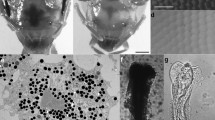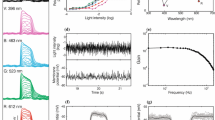Summary
-
1.
Electrical coupling between R1–6 photoreceptors was investigated by measuring angular sensitivities and quantum bumps.
-
2.
Recordings were made from two extreme types of cells: Type a: cells with a diffraction-like angular sensitivity profile (see Smakman et al. 1984). Only large bumps could be obtained from these cells. Type b: cells with large, asymmetrical sidebands in the angular sensitivity profile. Large and small bumps could be recorded from these cells, specifically with off-axis illumination.
-
3.
The position of the small sidebands of the type a cells depends strongly on wavelength, as expected for a diffraction curve. The position of the large asymmetrical sidebands in the angular sensitivity profile of the type b cells was found to be independent of wavelength, indicating that these sidebands are not caused by the diffraction pattern of the facet lens.
-
4.
The angular position of the large asymmetrical sidebands corresponds with the position of neighbouring photoreceptors, suggesting electrical interactions between R1–6 photoreceptors.
-
5.
The dependence of this electrical coupling on microelectrode properties was investigated. It was possible to change the degree of electrical coupling by selection of electrodes.
-
6.
The difference in properties of the two cell types encountered are interpreted as an indication that some R1–6 photoreceptors are artificially electrically coupled while others are not. The correlation of the electrical coupling with electrode types and the possible artificial origins of coupling are discussed.
Similar content being viewed by others
References
Beersma DGM (1979) Spatial characteristics of the visual field of flies. Thesis Groningen
Behrens ME, Wulff VJ (1965) Light-initiated responses of retinula and eccentric cells in theLimulus lateral eye. J Gen Physiol 48:1081–1093
Bernard GD, Wehner R (1980) Intracellular optical physiology of the bee's eye. 1. Spectral sensitivity. J Comp Physiol 137:193–203
Brown KT, Flaming DG (1977) New microelectrode techniques for intracellular work in small cells. Neuroscience 2:813–827
Doujak FE (1984) Electrophysiological measurement of photoreceptor membrane dichroism and polarization sensitivity in a grapsid crab. J Comp Physiol A 154:597–605
Dubs A (1982) The spatial integration of signals in the retina and lamina of the fly compound eye under different conditions of luminance. J Comp Physiol 146:321–343
Dubs A, Laughlin SB, Srinivasan MV (1981) Single photon signals in the fly photoreceptors and first interneurons at behavioural threshold. J Physiol (Lond) 317:317–334
Hateren JH van (1986) Electrical coupling of neuro-ommatidial photoreceptor cells in the blowfly. J Comp Physiol A 158:795–811
Horridge GA, Marçelja L, Jahnke R, Matiç T (1983) Single electrode studies on the retina of the butterflyPapilio. J Comp Physiol 150:271–294
Howard J (1983) Variations in the voltage response to single quanta of light in the photoreceptors ofLocusta migratoria. Biophys Struct Mech 9:341–348
Järvilehto M (1985) The eye: vision and perception. In: Kerkut GA, Gilbert LI (eds) Comprehensive insect physiology, biochemistry and pharmacology, vol 6. Pergamon Press, Oxford, pp 356–429
Kirschfeld K (1967) Die Projektion der optischen Umwelt auf das Raster der Rhabdomere im Komplexauge vonMusca. Exp Brain Res 3:248–270
Kirschfeld K, Franceschini N (1969) Ein Mechanismus zur Steuerung des Lichtflusses in den Rhabdomeren des Komplexauges vonMusca. Kybernetik 6:13–22
Lillywhite PG (1978) Coupling between locust photoreceptors revealed by a study of quantum bumps. J Comp Physiol 125:13–27
Menzel R, Blakers M (1976) Colour receptors in the bee eye — morphology and spectral sensitivity. J Comp Physiol 108:11–33
Mimura K (1978) Electrophysiological evidence for interaction between retinula cells in the flesh-fly. J Comp Physiol 125:209–216
Mimura K (1981) Receptive field patterns in photoreceptors of the fly. J Comp Physiol 141:349–362
Pask C, Barrell KF (1980) Photoreceptor optics II: Application to angular sensitivity and other properties of a lens-photoreceptor system. Biol Cybern 36:9–18
Shaw SR (1967) Simultaneous recording from two cells in the locust retina. Z Vergl Physiol 55:183–194
Shaw SR (1969) Interreceptor coupling in ommatidia of the drone honey-bee and locust compound eye. Vision Res 9:999–1029
Shaw SR (1984) Early visual processing in insects. J Exp Biol 112:225–251
Shaw SR, Stowe S (1982) Photoreception. In: Atwood HL, Sandeman DC (eds) The biology of Crustacea, vol 3. Academic Press, New York, pp 291–367
Smakman JGJ, Pijpker BA (1983) An analog-digital feedback system for measuring photoreceptor properties with an equal response method. J Neurosci Meth 8:365–373
Smakman JGJ, Hateren JH van, Stavenga DG (1984) Angular sensitivity of blowfly photoreceptors: Intracellular measurements and wave-optical predictions. J Comp Physiol A 155:239–247
Srinivasan M, Laughlin SB, Dubs A (1982) Predictive coding: a fresh view of inhibition in the retina. Proc R Soc Lond B 216:427–459
Wijngaard W, Stavenga DG (1975) On optical crosstalk between fly rhabdomeres. Biol Cybern 18:61–67
Author information
Authors and Affiliations
Rights and permissions
About this article
Cite this article
Smakman, J.G.J., Stavenga, D.G. Angular sensitivity of blowfly photoreceptors: broadening by artificial electrical coupling. J. Comp. Physiol. 160, 501–507 (1987). https://doi.org/10.1007/BF00615083
Accepted:
Issue Date:
DOI: https://doi.org/10.1007/BF00615083




